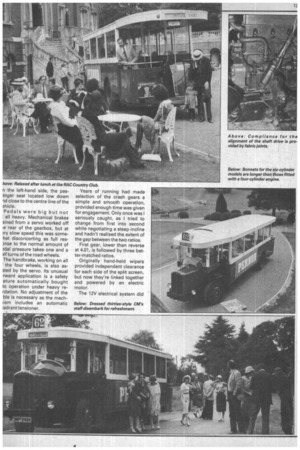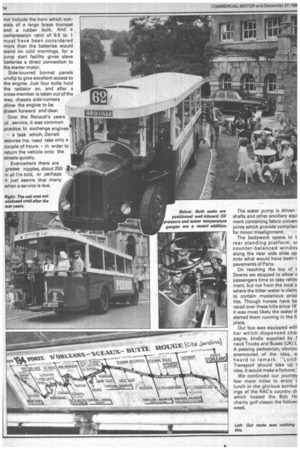French nostalgia in England's green fields
Page 14

Page 15

Page 16

If you've noticed an error in this article please click here to report it so we can fix it.
FEW VEHICLES nearing fifty years of age are used regularly and cover 10,000 miles a year, but Derrett Williams, film producer, publican and historic .vehicle enthusiast has two such vehicles. Both are Paris buses, hired out for promotional work at exhibitions and shows all over the country.
They no longer work as psv but still thousands of people tramp on and off them every year.
Earlier in CM's 75th anniversary year we took one — a Renault TN6A for a summer excursion. We invited a number of CM's staff along, but on condition that they dressed for the occasion — and that meant in Thirties style.
Our new Sutton offices were chosen as the starting point and we then headed for the RAC Country Club at Woodcote Park, once the home of the Baron de Teissier. He has no claim to fame other than being inadvertently responsible for Queen Victoria's aversion to the sport of kings. Built in 1933, the Renault TN6A was just one of 1,020 built between 1931 and 1935, which continued to work in the streets of Paris until 1969 before being bought by Derrett and driven to England. There are a few others still in existence, of which nine prized examples are on this side of the Channel.
The large six-cylinder in-line type 364 petrol engine ran without giving trouble for a further five years but then began to lose water. The head gasket was suspect at first but the cause was finally traced to the head itself which was found to be porous. New heads for old blocks are understandably rarely available off the shelf. For a while, a fourcylinder Perkins diesel was adopted as a temporary replacement to keep the vehicle on the road.
A little while later, Derrett heard that a batch of old bus parts had come to light in a bus garage stock-take.
Doubting such a supply should ever become available again Derrett drove over and, after agreeing a price, bought back all he could carry in the back of his car.
Over the years he has collected other components so that the tithe barn at Lower Hardnes, Kent, which serves as a garage and workshop, is now wellequipped to deal with most breakdowns.
The tyres used to fit the solid dished wheels are an odd size, 38 x 8, and are particularly difficult to replace. But a friendly local tyre dealer helped out by retreading eight of the original tyres bought with the vehicle.
The bodies of both fourand six-cylinder models are identical, differing only in bonnet length which, heavily louvred, provides ventilation for the engine.
Though the Renault TN6A was the first French bus to be equipped with a front screen, the warm flow of heat must have been welcomed by the driver for, until the end of the war, the cab still had open sides.
For a few years the Renault was in the service of the Riech having been commandeered for transporting German force Some were converted to run I wood gas and other equa doubtful fuels.
A step on the nearside frc wing provides access to the 1€ hand driving seat, a bucket aff which, though giving a comfa able enough seating position,
located low down in relation the steering wheel and foot r dals.
First gear is very low and not need to be used for drivi away from rest on a level sti but it enabled the vehicle to r tart on the steep incline J broaching Montmartre with full complement of 50 passes ers — 33 seated and 17 standir As we headed out along A217 on our summer jaunt, carried about 20 passengE Other traffic on the road seen' to slow down for a longer k rather than being held up by u Second gear acceleration reckoned to be about the sa as that of a London clout decker — surprisingly swift the low-revving engine ratec 67CV )the French equivalen1 horsepower) at 1,350rpm.
The driving seat was of cou n the left-hand side, the pasanger seat located low down id close to the centre line of the ahicle.
Pedals were big but not : all heavy. Mechanical brakes ained from a servo worked off le rear of the gearbox, but at .iry slow speed this was somehat disconcerting as full res)nse to the normal amount of :dal pressure takes one and a Of turns of the road wheels.
The handbrake, working on all the four wheels, is also as3ted by the servo. Its unusual rward application is a safety ature automatically bought to operation under heavy rerdation. No adjustment of the ble is necessary as the rnechiism includes an automatic ad rant tensioner. Years of running had made selection of the crash gears a simple and smooth operation, provided enough time was given for engagement. Only once was I seriously caught, as I tried to change from first into second while negotiating a steep incline and hadn't realised the extent of the gap between the two ratios.
First gear, lower than reverse at 4.01, is followed by three better-matched ratios.
Originally hand-held wipers provided independent clearance for each side of the split screen, but now they're linked together and powered by an electric motor.
The 12V electrical system did not include the horn which consists of a large brass trumpet and a rubber bulb. And a compression ratio of 6.5 to 1 must have been considered more than the batteries would stand on cold mornings, for a jump start facility gives slave batteries a direct connection to the starter motor.
Side-louvred bonnet panels unclip to give excellent access to the engine. Just four bolts hold the radiator on, and after a cross-member is taken out of the way, chassis side-runners allow the engine to be drawn forward and clear.
Over the Renault's years of service, it was common practice to exchange engines — a task which, Derrett assures me, need take only a couple of hours — in order to return the vehicle onto the streets quickly.
Everywhere there are grease nipples, about 250 in all I'm told, or perhaps it just seems that many when a service is due. The water pump is driven shafts and other ancillary equi ment containing fabric univerf. joints which provide complian for minor misalignment.
The bodywork opens to t rear standing platform, ar counter-balanced windov along the near side slide op onto what would have been t pavements of Paris.
On reaching the top of t Downs we stopped to allow c passengers time to take refreE ment, but not from the local s where the bitter water is claim to contain mysterious prop, ties. Though horses have be raced over these hills since 16' it was most likely the water tr• started them running in the fi place.
Our bus was equipped witt bar which dispensed chai pagne, kindly supplied by f nault Trucks and Buses (UK) L A passing pedestrian, obviou: enamoured of the idea, vv heard to remark: "Lond: Transport should take up t idea. It would make a fortune.'
We continued our journey few more miles to enjoy C lunch in the glorious surrour ings of the RAC's country air which hosted the Bob Ho charity golf classic the followi week.












































































